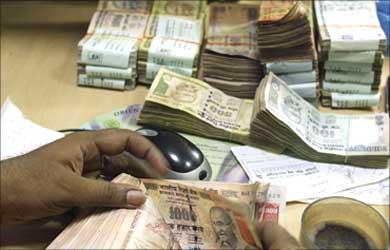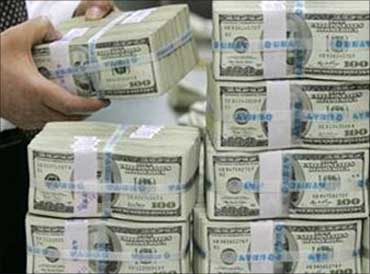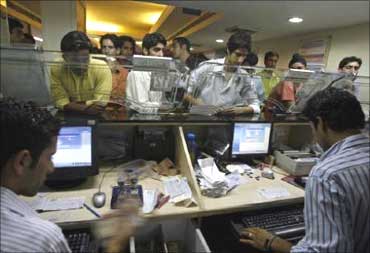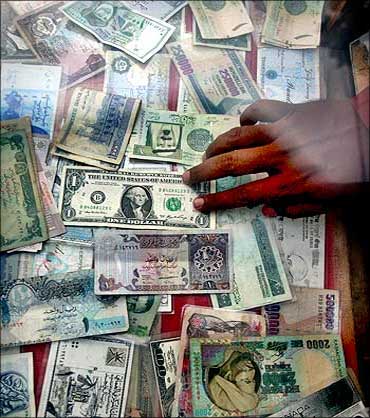 | « Back to article | Print this article |
How your money can become cashless
The worldwide mobile money user base will tip the billion mark in five years, from 45 million to 55 million now*.
Value wise, it is expected to cross $379 billion in three years**. Add domestic and international money transfers and the total could be $1 trillion.
For mobile network operators this means an extra $5 billion per year in direct revenues from service fees on such transactions.
And an additional $3 billion from indirect revenue from reduced churn and higher ARPUs (average revenue per user)***
As far as India is concerned, the potential is huge given that (a) the mobile phone with a penetration of 60 per cent of the population is now officially ubiquitous and (b) in a few years there will be a billion mobile users in India - far more than the Doordarshan, cable & satellite, internet, print and radio universe combined.
The mobile cell phone will act as the proverbial digital Swiss knife for the aam admi - cater to everyday communication, information, networking, entertainment and financial services needs.
* McKinsey & Co; Berg Insight; **Gemalto; *** Mc Kinsey & Co
Click on NEXT to read more...
How your money can become cashless
A recent Economist study indicates that in emerging economies like India, traditional retail channel dependency will skip the traditional teller, branch and internet and telephone channels, directly to mobile - not just to leverage the penetration of the mobile but on account of the favourable economics for service delivery of this channel over all others.
The economics of the mobile phone to deliver a financial service is a tenth that of the next most efficient channel - the internet - and potentially a 100th of going to the bank or using a teller service.
Since the Reserve Bank of India's mobile banking guidelines came out in late 2008, more than 40 banks already have some form of mobile financial service offered to their customer base.
This provides a readymade base of 100-million plus.
Click on NEXT to read more...
How your money can become cashless
So, what will make mobile money mainstream?
First, telecom companies and their innate ability to offer a triple combo of low-cost mobile phones, 3G rollout and competitive pressures in data plans.
These will make it affordable for the masses to transact over the mobile Internet without worrying about increased bills.
Second, banks and solution providers (aggregators) will need to ease the overall customer experience.
This means intuitive navigation, minimal keystrokes and screens matched to relevant benefits - remittance, savings, credit, repayments, recovery and so on.
To reduce the mental barrier towards adopting something new, they will need to incentivise consumers.
Among the first useful steps are automatic or simple registration procedures for the service or even migrating the current Internet banking and ATM user into it.
Click on NEXT to read more...
How your money can become cashless
It will not, however, be enough to have the under-banked and hitherto excluded 60 per cent of India's population open "no frills accounts" and then keep them dormant.
A "bank account" must serve a pecuniary benefit in the eye of the holder, something that caters to his needs. So we have make the account a "store of value", and therefore interest-bearing.
But more important, a gateway for a whole range of sachet-type financial services needs to be accessed - remittance, overdraft, micro credit, pension, micro loan, micro overdraft, micro insurance, mutual funds, NREGA and so on.
Unfortunately, linking inclusion with the precondition of being formally banked has been a deterrent to the aam admi over several generations.
But today, most wage earners own a mobile phone but do not necessarily have a relationship with a bank.
We can influence citizen behaviour like never before by getting a person to transact electronically. This by itself is a big paradigm shift.
The next step will be to link that transaction to a formal banking method and a unique Aadhar number.
Click on NEXT to read more...
How your money can become cashless
Third, if there are many touch points at which people use their mobile phone to make payments or transfer then the network externalities are obvious.
Currently, in a country the size of India, the point of sale (POS) base is a ludicrous 350,000-odd.
Organised retail covers a mere three per cent of the population and the perverse economics practices by banks and global credit card companies have resulted in low penetration of POS devices.
This is no longer tenable and has to be radically rethought - the entry-level mobile phone itself has to become the de facto POS device.
Now, imagine a situation in which more than a million people across India are merchants, and can also act as cash in/cash-out points, financial service points or business correspondents.
And where a billion others can transact access, pay, buy, top up or receive financial services. In short, the ubiquity of the mobile phone must be matched by infrastructure.
Finally, innovation is key. I am cautious about banks' ability to drive innovation and adoption. No one would disagree that today's banks have to be the gold standard for prudential risk.
The final winner for these services is still something on which the jury is out. But product innovation is where it starts.
Click on NEXT to read more...
How your money can become cashless
Here are the seeds of two. For one, banks can and should issue their own branded or co-badged e-wallets. These can be topped up via net banking or credit card or even ATMs.
This way all the base requirements of know-your-customer norms would be taken care of.
The redemption is within the accepting merchant base; these work in the semi-open loop and bring more value added services (ticketing, recharge, shopping, bill payment, subscriptions, renewals, money transfer, remittances, donations) to the customer.
If they don't, then telecom companies will soon occupy that space - they have already started to do so with a major service provider obtaining a licence to do so.
Other e-money innovations are platform-centric server-based e money, which are pre-funded personalised accounts or linked to an account, wherein the credit and debits lie virtually on a server.
These can apply to online payments, and use the mobile for authentication and confirmation.
These will lead to the change we want to see.
The author is Co Founder & Promoter, PayMate






